The Secret Chemicals in Fast Food and What They’re Doing To You

You don’t need a scientist to tell you that fast food is not a healthy choice.
Empty calories? Check.
Heavy in trans fat, light in nutrition? Check.
The exact opposite of mindful and grateful eating? Check.
But it’s important to understand that not only is fast food not good for you, it’s actively harmful to your body’s composition.
The reason is that the chemicals and preservatives used to keep fast food convenient, constantly available, and addictive are inorganic and disastrous to your operating systems.
In a podcast episode with bestselling author Seth Siegel, we talked about the way the EPA regulates chemicals in drinking water — and he noted something shocking.
The EPA has not added a new chemical to its water-regulation list in 20 years. And yet, thousands of chemicals a year are invented and introduced into our collective ecosystem.
Now, the FDA, which is responsible for making all food in America safe, has got hundreds of documents on food additives and appropriate quantities.
Fast food restaurants are required to include the nutritional value of their wares.
So what don’t we know?
Let’s look into some of the more common chemicals in fast food and what they actually do in your body.
Propylene Glycol
This synthetic substance is used as a commercial lubricant and can also be found in antifreeze and deodorant.
In the fast food industry, it is used to make spice concentrates, food colorings, and flavorings.
In the body? At high concentrations, it can cause seizures and neurological issues.
Caramel Coloring (Containing both 2 and 4-methylimidazole)
If you’re eating caramel-colored fast food, it’s likely dyed with this compound. It’s a food additive made from a synthetic compound which resulted from sugars with ammonia reacting with sulfite, creating 2 and 4-methylimidazole.
Put simply? Those two chemicals have been connected to thyroid, liver, and lung cancer.
The U.S. Center for Science and Public Interest has specifically recommended avoiding it. And yet…
Silicon Dioxide
A fancy word for sand.
Fast food restaurants use this additive to prevent clumping in meat-based items, like soups and chilis.
When it’s not making its way into your digestive tract, it can be found in cement, ceramics, and glass.
And it’s horrendous for leaky gut syndrome.
Cellulose
This is essentially sawdust. And it’s used as a way to avoid paying for actual thickening agents like flour or oil.
Because it’s considered a plant-based, nondigestible fiber, experts say that it doesn’t harm your digestive system unless taken in large quantities.
What it does do is fill up space in fake food and make you process fast food faster than you would normal food.
TBHQ
Tertiary butylhydroquinone comes from petroleum. Yes, fuel.
It’s commonly employed to keep fast food “fresh” for longer. Think about how long it takes fast food to decompose… if it does at all.
Used in “excessive” quantities, it wreaks havoc on your system, causing nausea, vomiting, tinnitus, and delirium.
Dimethylpolysiloxane
This is what Silly Putty is made of (breast implants, too.)
Fast food joints use this silicon compound to keep the oil in their deep fryers from foaming, which means they don’t have to change their oil as often.
The interesting thing about this chemical is that the FDA allows it to be guarded by chemicals that aren’t required to be listed on the label, like formaldehyde, which can cause allergies, brain damage, cancer, and autoimmune disorders.
It’s also known to be damaging to your eyes and respiratory system. Not to mention it brings on bouts of aggravated acne.
Sodium Acid Pyrophosphate
This chemical is an edible phosphoric salt, and it’s used as a leavening agent and discoloration preventer.
Think about hash browns, french fries, or nuggets. It fluffs up foods that would otherwise mold, dry out, blacken, or stiffen.
In the body, it can cause vision problems and cardiovascular disease.
When this compound appears in laxatives, it causes dehydration, electrolyte imbalances, and bone and tooth decay.
Grossed out yet?
The FDA classifies many of these chemicals and synthetics as GRAS — generally recognized as safe.
What that usually means is food must contain an almost untraceable amount of these chemicals — but it may contain lots of different kinds.
So although it may seem like you’re saving a few pennies on the drive-thru coming home from work, the long term cost to your health and safety is not really worth the convenience.
For more life-changing information on our mental, emotional, physical, and spiritual health, check out my streaming service — whole.tv — with this two-week free trial.








